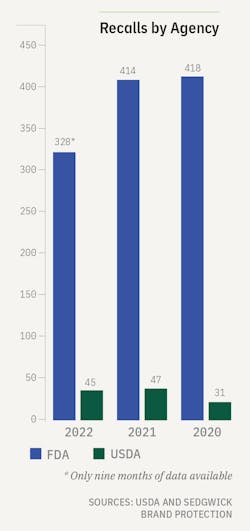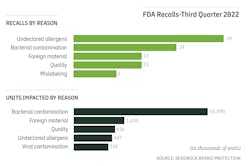Heavy metals, other chemicals in food, a radically new FDA and a war on salmonella: Those appear to be the food safety priorities for 2023.
Now that we can put Covid, at least as a pandemic, behind us, food safety has pretty much returned to the old normal. Do credit the pandemic for some permanent changes – for example, more automation, more space for plant-floor workers and more use of remote technologies.
But if 2022 news foretells actions in 2023, those four items in the first paragraph seem to be at the top of the lists for the food safety agencies … and consequently should be atop the list of any food or beverage processor.
Radical changes at FDA?
But perhaps there never has been as much pressure to rewrite the FDA as there was in 2022. Last April, Politico revealed a months-long investigation that trashed the agency, quoting past FDA employees, even former commissioners. It criticized the agency's slow pace and pointed to the split of food responsibilities—Frank Yiannas as deputy commissioner for food policy and response and Susan Mayne as the director of the Center for Food Safety and Applied Nutrition—as part of the problem.
The report also acknowledged the FDA has two huge areas of responsibility, and drugs have become a priority of late; plus the entire agency is not a cabinet-level department but a subset of the Dept. of Health and Human Services (HHS).
In the wake of that story, Consumer Brands Assn. and 27 other organizations signed a letter asking FDA Commissioner Robert Califf to revamp the agency and to consider a single deputy commissioner overseeing all things relating to food.
Midsummer saw Congressional hearings on the matter. Representatives in both houses introduced a joint bill to remove responsibility for food safety from the FDA and create a new agency under HHS that would perform the functions of the FDA’s Center for Food Safety and Applied Nutrition, Center for Veterinary Medicine and the Office of Regulatory Affairs.
Great theater, but the bill went nowhere.
Commissioner Califf reacted by asking the Reagan-Udall Foundation, an independent policy organization, for a report. By year end, the group suggested many of the same ideas: split food off from FDA and name a single person in charge of food related issues.
“My take is there wasn't a lot in that report that hadn't been said in the past but I think it pulls a lot together and focuses it,” says David Acheson, a former FDA associate commissioner for foods and founder and CEO of The Acheson Group, a consulting firm with a focus on food safety and risk management.
The Reagan-Udall report “was requested by the commissioner, and the commissioner has promised to take action at some point in 2023,” Acheson said in his group’s year-end webinar. “Some of the suggestions were really good – establishing a separate center for nutrition I think is an excellent idea and frankly long overdue.”
The FDA got two black eyes last year from the infant formula “crisis.” After dozens of babies became ill and two died early in 2022, there was a recall of infant formula made at an Abbott plant in Sturgis, Mich. Upon subsequent inspection by the FDA – many asked why it was “subsequent” – the plant was found to have deplorable conditions that apparently led to the cronobacter contamination.
That was strike one for the FDA. Strike two came when this, the biggest formula-supplying plant in the country, was shut down and it triggered a nationwide shortage of formulas. Again the agency was blamed – probably unfairly, because antitrust issues are the domain of the Federal Trade Commission, but the FDA put the wheels in motion.
Meanwhile, regular business continues at FDA, with one staffing exception. Yiannas submitted his resignation in late January in the wake of the fumbled FDA response to the 2022 infant formula supply and food safety crisis. His resignation goes into effect Feb. 24, 2023.
The final Food Traceability Rule, with its Food Traceability List, was announced in November 2022, so most companies will spend this year getting ready for its January 2026 enforcement date. And sesame has joined the major food allergen list, so this allergen must be declared on food labels.
While the sesame rule went into effect Jan. 1, it does not require food products that were already on their way to the store or in stock before 2023 to list sesame as an allergen on the label. Therefore, these food products do not need to be removed from the marketplace or relabeled to declare sesame.
Sesame joins eight other foods already on the allergen list: milk, eggs, fish, crustaceans and shellfish, tree nuts, peanuts, wheat and soybeans.
PFAS and heavy metals
The FDA also took heat in 2022 for the long-running concern of heavy metals in baby foods, especially rice-based ones. Just last month, the agency revealed a draft guidance for action levels of lead in infant foods. It’s the first step in the agency’s announced “Closer to Zero” strategy.
The proposed limits are:
- 10 parts per billion (ppb) for fruits, vegetables (excluding single-ingredient root vegetables), mixtures (including grain and meat-based mixtures), yogurts. custards/puddings and single-ingredient meats.
- 20 ppb for root vegetables (single ingredient).
- 20 ppb for dry cereals.
“The FDA considers these action levels to be achievable when measures are taken to minimize the presence of lead and expects that industry will strive for continual reduction of this contaminant,” the agency wrote in its Jan. 24 announcement. “The baby foods have differing action levels, to account for variances in consumption levels of different food products and due to some foods taking up higher amounts of lead from the environment.”
The FDA and other agencies have long been aware of the presence of heavy metals –including lead, arsenic, cadmium and mercury – in food, especially infant foods, but this is the first concrete action. The subject reached a boiling point last summer.
“A Congressional report early in 2021 was pretty outspoken around the levels of certain heavy metals in infant foods,” David Acheson, a former FDA associate commissioner for foods and founder and CEO of The Acheson Group, said in his consulting firm’s year-end webinar. “It garnered a lot of a lot of attention from social and mainstream media, but not a lot happened in 2021. But it definitely gained momentum so that in 2022 we now have a whole new initiative from FDA: ‘Closer to Zero.’ ”
The FDA announced Closer to Zero in April 2021. The agency promised to evaluate the science and propose “appropriate” levels for those metals in consultation with manufacturers, consumers and other stakeholders. Lead apparently is the first.
“But there are some big challenges and I think that was why cleverly FDA called this Closer to Zero and not [implying] we can zero out heavy metals, because we cannot do that,” Acheson continued.
These draft guidances usually are followed by a comment period before becoming final. The FDA is considering the more than 1,100 comments it received in November 2021 during the "Closer to Zero Action Plan” public meeting. Also, the FDA will host a webinar soon to explain the draft guidance and answer stakeholder questions. More details on the webinar will be announced shortly.
PFAS was a new acronym for many in 2022, and one that will probably be seen a lot in 2023. Per- and polyfluoroalkyl substances are widely used, long lasting chemicals that break down very slowly over time – hence their moniker “forever chemicals.” They’re particularly prevalent in food packaging.
Ironically, one of the main ways PFAS can contaminate food is through recycled packaging materials, according to Environmental Health Sciences. Because PFAS are such persistent chemicals, they can accumulate in recycled paper or wood pulp, either because the recycled material was coated in PFAS or it came into contact with PFAS unintentionally.
How harmful they are is not well understood. “There are thousands of PFAS chemicals, and they are found in many different consumer, commercial and industrial products,” says the Environmental Protection Agency. “This makes it challenging to study and assess the potential human health and environmental risks.”
But some studies have linked them to some cancers, reproductive problems and birth defects, among other concerns. So consumers are starting to ask food & beverage processors if they’re present in their products or their packaging.
“A lot of companies have done the due diligence, asking their packaging suppliers and ingredient suppliers ‘What are you doing to ensure that you're not sending us any food or packaging with any of these forever chemicals?’ ” asks Acheson. “The vast majority of companies have stopped using them and adding them deliberately but they remain around.”
No action seems imminent from any federal agency nor Congress, but the issue is heating up and some remedies may be at least proposed during this new year.
USDA declares war on salmonella
USDA didn’t have to endure the gut punches FDA took in 2022. As 2023 unfolds, the agency’s food safety priorities include reducing illnesses from salmonella, primarily in poultry products, proposing new labeling requirements for cell-cultured meat and poultry and defining was a “Product of USA” label means.
The Dept. of Agriculture declared war on salmonella at the end of 2021. Over the past year, the agency’s Food Safety and Inspection Service began gathering the data and information necessary to develop “a new regulatory strategy” that may enable its stated target of a 25% reduction in Salmonella illnesses.
The agency published a proposed regulatory framework for this new strategy that consists of three components:
- Requiring that incoming flocks be tested for salmonella before entering a facility
- Enhancing plants’ process control monitoring and FSIS verification
- Implementing an enforceable final standard
“FSIS held a public meeting on the framework and is currently reviewing comments submitted,” a spokesperson told us. “The agency continues to discuss its proposed strategy with a wide range of stakeholders, evaluate recommendations by its advisory committee, and awaits completion of risk assessments.”
To those who understand the nuance, an important step was an August 2022 notice that the agency intends to declare salmonella in breaded and stuffed raw chicken products an adulterant. “If the declaration is finalized as proposed, such products will be considered adulterated when they exceed a very low level of salmonella contamination, which means they would not be allowed in commerce,” the spokesperson explained.
In 2019, FSIS and FDA established a formal agreement regarding the shared regulatory oversight of products made from cultured animal cells. Under this agreement, FDA oversees cell collection, cell banks and cell growth and differentiation. FSIS then oversees the further processing, labeling and packaging of these products – essentially when they become recognizable meat products.
While currently there are no food products made from cultured animal cells available in U.S., Upside Foods, formerly Memphis Meats, late last year received FDA approval for the first steps at bringing those products to market. FSIS has to develop safety protocols for the eventual processing steps and also the proper labeling of these products.
Finally, country-of-origin labeling has been a contentious issue over the past few years. In July 2021, USDA announced it would undertake a comprehensive review of the voluntary “Product of USA” label claim that can be applied to products regulated by FSIS. USDA took this action after receiving three petitions asserting that the current label claim may confuse consumers.
“FSIS’ review of this label claim is intended to better understand what the “Product of USA” label means to consumers and inform any necessary revisions to FSIS’ labeling regulations,” the spokesperson said. “As part of the review, FSIS commissioned a nationwide consumer survey to gauge consumer understanding and value of the claim.”




